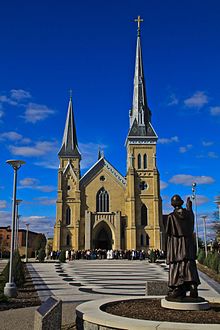Cathedral of Saint Andrew (Grand Rapids, Michigan)
| Cathedral of Saint Andrew | |
|---|---|
 East façade on the Piazza Secchia | |
 Location in Michigan | |
| 42°57′29″N 85°40′02″W / 42.95804°N 85.66713°WCoordinates: 42°57′29″N 85°40′02″W / 42.95804°N 85.66713°W | |
| Location | 215 Sheldon Blvd. SE Grand Rapids, Michigan |
| Country | United States |
| Denomination | Roman Catholic Church |
| Website | www |
| History | |
| Founded | 1833 |
| Architecture | |
| Style | Gothic Revival |
| Completed | 1876 |
| Specifications | |
| Height | 192 feet (59 m) |
| Materials | Limestone |
| Tenor bell weight | 213 |
| Administration | |
| Diocese | Grand Rapids |
| Clergy | |
| Bishop(s) | Most Rev. David J. Walkowiak |
| Rector | Very Rev. René Constanza, C.S.P. |
The Cathedral of Saint Andrew is a Catholic cathedral located in Grand Rapids, Michigan, United States. It is the seat of the Diocese of Grand Rapids.[1]
History[]
St. Andrew’s history traces its beginning to the founding of St. Mary’s Church by the Rev. Frederic Baraga.[2] He built a small church, rectory and school on the west bank of the Grand River and the people who attended the church were Native Americans. The Rev. Andreas Viszoczky was named the parish’s first pastor two years later. After the Native Americans left and the town of Grand Rapids grew, Father Viszoczky built a new church on Monroe Street which he named St. Andrew. The church building was constructed of Grand River limestone and completed in 1850.
Grand Rapids continued to grow as did the parish and a new church was soon needed. In 1875, the present church was started on Sheldon Boulevard and completed a year later. On May 19, 1882 Pope Leo XIII established the Diocese of Grand Rapids.[3] The diocese’s first bishop Henry J. Richter chose Saint Andrew’s as his cathedral and was consecrated in it on April 22, 1883.[2]
Lightning struck the cathedral in 1901 and a fire destroyed part of the church building. It was rebuilt and expanded. Some of the wooden beams above the ceiling still show the charred marks from the fire. A television studio was created in the cathedral in the 1950s to televise a weekly Sunday Mass. The cameras have been updated in the 21st century to provide for digital broadcasts. Another expansion of the cathedral facilities occurred from 1961-1963. The St. Ambrose Chapel wing was added at that time and Maple Street from Sheldon to Division was closed and a green space created.
A major renovation of the cathedral in 1979-1980 brought the altar forward into the congregation and a vesting and gathering area was created. Another major renovation from 1997-2000 created a baptismal pool and refurbished the stained glass windows and the Stations of the Cross. The current pipe organ was installed in 2002. The front entrance of the cathedral was remodeled in 2009 and the Piazza Secchia was laid. It is patterned after the piazza created by Michelangelo on the Capitoline Hill in Rome.
See also[]
- List of churches in the Roman Catholic Diocese of Grand Rapids
- List of Catholic cathedrals in the United States
- List of cathedrals in the United States
References[]
- ^ "Cathedral of St. Andrew". GCatholic. Retrieved 2011-09-20.
- ^ a b "Our History". Cathedral of Saint Andrew. Archived from the original on 2011-08-09. Retrieved 2011-09-21.
- ^ "Diocese of Grand Rapids". Catholic-Hierarchy. Retrieved 2011-09-21.
External links[]
![]() Media related to Saint Andrew Cathedral (Grand Rapids, Michigan) at Wikimedia Commons
Media related to Saint Andrew Cathedral (Grand Rapids, Michigan) at Wikimedia Commons
- Churches in the Roman Catholic Diocese of Grand Rapids
- Religious organizations established in 1833
- 1833 establishments in Michigan Territory
- Roman Catholic churches completed in 1876
- Roman Catholic cathedrals in Michigan
- Churches in Grand Rapids, Michigan
- Gothic Revival church buildings in Michigan
- 19th-century Roman Catholic church buildings in the United States

